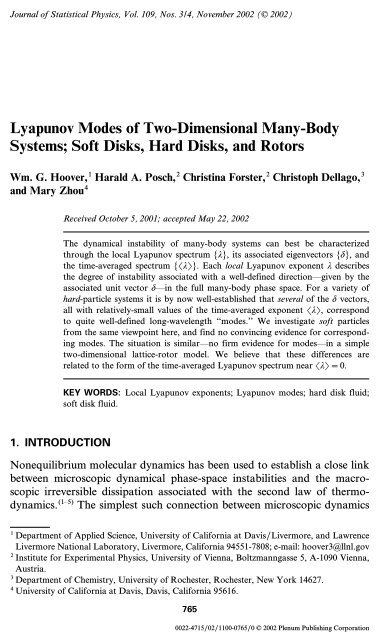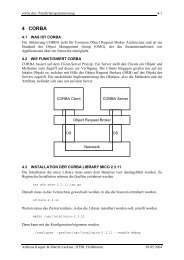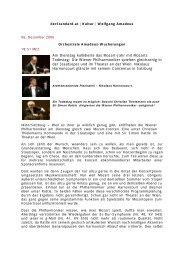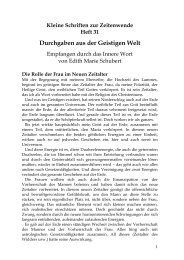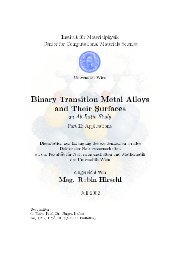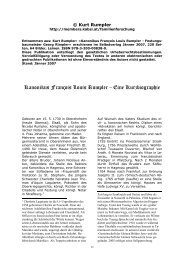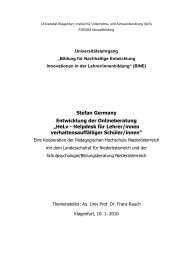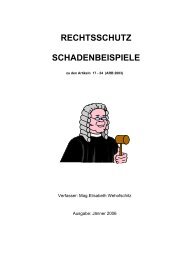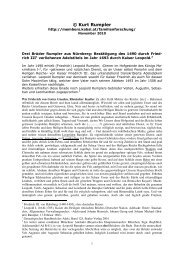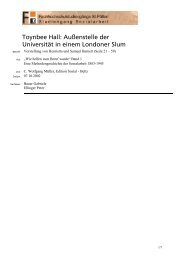Lyapunov Modes of Two-Dimensional Many-Body Systems; Soft ...
Lyapunov Modes of Two-Dimensional Many-Body Systems; Soft ...
Lyapunov Modes of Two-Dimensional Many-Body Systems; Soft ...
You also want an ePaper? Increase the reach of your titles
YUMPU automatically turns print PDFs into web optimized ePapers that Google loves.
Journal <strong>of</strong> Statistical Physics, Vol. 109, Nos. 3/4, November 2002 (© 2002)<br />
<strong>Lyapunov</strong> <strong>Modes</strong> <strong>of</strong> <strong>Two</strong>-<strong>Dimensional</strong> <strong>Many</strong>-<strong>Body</strong><br />
<strong>Systems</strong>; S<strong>of</strong>t Disks, Hard Disks, and Rotors<br />
Wm. G. Hoover, 1 Harald A. Posch, 2 Christina Forster, 2 Christoph Dellago, 3<br />
and Mary Zhou4 1. INTRODUCTION<br />
Received October 5, 2001; accepted May 22, 2002<br />
The dynamical instability <strong>of</strong> many-body systems can best be characterized<br />
through the local <strong>Lyapunov</strong> spectrum {l}, its associated eigenvectors {d}, and<br />
the time-averaged spectrum {OlP}. Each local <strong>Lyapunov</strong> exponent l describes<br />
the degree <strong>of</strong> instability associated with a well-defined direction—given by the<br />
associated unit vector d—in the full many-body phase space. For a variety <strong>of</strong><br />
hard-particle systems it is by now well-established that several <strong>of</strong> the d vectors,<br />
all with relatively-small values <strong>of</strong> the time-averaged exponent OlP, correspond<br />
to quite well-defined long-wavelength ‘‘modes.’’ We investigate s<strong>of</strong>t particles<br />
from the same viewpoint here, and find no convincing evidence for corresponding<br />
modes. The situation is similar—no firm evidence for modes—in a simple<br />
two-dimensional lattice-rotor model. We believe that these differences are<br />
related to the form <strong>of</strong> the time-averaged <strong>Lyapunov</strong> spectrum near OlP=0.<br />
KEY WORDS: Local <strong>Lyapunov</strong> exponents; <strong>Lyapunov</strong> modes; hard disk fluid;<br />
s<strong>of</strong>t disk fluid.<br />
Nonequilibrium molecular dynamics has been used to establish a close link<br />
between microscopic dynamical phase-space instabilities and the macroscopic<br />
irreversible dissipation associated with the second law <strong>of</strong> thermodynamics.<br />
(1–5) The simplest such connection between microscopic dynamics<br />
1 Department <strong>of</strong> Applied Science, University <strong>of</strong> California at Davis/Livermore, and Lawrence<br />
Livermore National Laboratory, Livermore, California 94551-7808; e-mail: hoover3@llnl.gov<br />
2 Institute for Experimental Physics, University <strong>of</strong> Vienna, Boltzmanngasse 5, A-1090 Vienna,<br />
Austria.<br />
3 Department <strong>of</strong> Chemistry, University <strong>of</strong> Rochester, Rochester, New York 14627.<br />
4 University <strong>of</strong> California at Davis, Davis, California 95616.<br />
765<br />
0022-4715/02/1100-0765/0 © 2002 Plenum Publishing Corporation
766 Hoover et al.<br />
and macroscopic dissipation results when a Nosé-Hoover thermostat is<br />
used to control a nonequilibrium steady state. In this case the instantaneous<br />
external entropy production rate (due to heat extracted by the<br />
thermostat) is proportional to the sum <strong>of</strong> the instantaneous <strong>Lyapunov</strong><br />
exponents:<br />
S ˙ /k — − C l.<br />
Such microscopic-to-macroscopic connections have focussed attention<br />
on these instantaneous (or ‘‘local’’) <strong>Lyapunov</strong> exponents, {l}, and their<br />
time averages, {OlP}. A very recent development is the discovery <strong>of</strong><br />
‘‘modes’’ (6–13) corresponding to the exponents. Because our current theoretical<br />
understanding <strong>of</strong> these modes, as well as the exponents themselves, is<br />
still rudimentary, the present work treats only equilibrium systems. These<br />
results can serve as a basis for extending our understanding to the farfrom-equilibrium<br />
systems which are a strong focus <strong>of</strong> current research in<br />
many-body dynamics.<br />
At equilibrium, and away, the local exponents together with their<br />
associated eigenvectors provide the fundamental microscopic description <strong>of</strong><br />
phase-space instability. Recent investigations (6–13) have shown that some <strong>of</strong><br />
the <strong>Lyapunov</strong> exponents, those describing relatively-weak instabilities with<br />
near-zero growth rates, correspond to wavelike eigenvectors, both longitudinal<br />
and transverse. The phase relations in these eigenvectors differ from<br />
those <strong>of</strong> acoustic waves. The coordinate and momentum displacements in<br />
the <strong>Lyapunov</strong> ‘‘modes’’ are ‘‘in phase’’ reflecting the exponential time<br />
dependence elt <strong>of</strong> <strong>Lyapunov</strong> instability. In acoustic waves the coordinate<br />
, reflecting their<br />
and momentum displacements have a phase difference <strong>of</strong> p<br />
2<br />
periodic time dependence eiwt .<br />
Computing these instantaneous eigenvectors requires additional<br />
N-body solutions, one for each vector, so that the work for a complete<br />
description varies as the square <strong>of</strong> the number <strong>of</strong> particles, N2 . Worse yet,<br />
the additional computational effort involved in keeping <strong>of</strong> the order <strong>of</strong> N2 eigenvectors orthonormal, where each eigenvector has <strong>of</strong> the order <strong>of</strong><br />
N components, varies as N3 . Nevertheless, presentday gigahertz serialprocessor<br />
work stations are capable <strong>of</strong> following the complete spectrum <strong>of</strong><br />
eigenvalues and eigenvectors for systems <strong>of</strong> a thousand particles.<br />
The present work describes detailed computations for s<strong>of</strong>t disks at<br />
equilibrium. Though some qualitative modelike character is present in the<br />
s<strong>of</strong>t-disk results the evidence is much less convincing than corresponding<br />
hard-disk simulations. Likewise, lattice-rotor simulations give no firm<br />
evidence for modes in two dimensions.
<strong>Lyapunov</strong> <strong>Modes</strong> <strong>of</strong> <strong>Two</strong>-<strong>Dimensional</strong> <strong>Many</strong>-<strong>Body</strong> <strong>Systems</strong> 767<br />
We review the definition and evaluation <strong>of</strong> the <strong>Lyapunov</strong> exponents<br />
and their associated d vectors in the next section. Numerical results follow,<br />
for a dense s<strong>of</strong>t-disk fluid, and we include corresponding observations for<br />
lattice-rotor problems. Our exploration <strong>of</strong> the fundamental question<br />
‘‘<strong>Modes</strong> or Not?’’ and our overall conclusions make up the final two<br />
sections.<br />
It is our great pleasure to dedicate this work to Bob Dorfman, whose<br />
generous, careful, and perceptive exploration <strong>of</strong> statistical mechanics (5) has<br />
enriched the field and our appreciation <strong>of</strong> it.<br />
2. LOCAL LYAPUNOV EXPONENTS<br />
The ‘‘local’’ (or ‘‘instantaneous’’) <strong>Lyapunov</strong> exponents quantify a<br />
special set <strong>of</strong> comoving and corotating (moving, and rotating, in the neighborhood<br />
<strong>of</strong> a particular ‘‘reference solution’’ in phase space) orthogonal<br />
expansion and contraction rates. For a two-dimensional system <strong>of</strong> N particles,<br />
the complete {x, y, p x,p y} phase space is 4N-dimensional, and 4N<br />
local <strong>Lyapunov</strong> exponents {l} describe the expansion and contraction rates<br />
<strong>of</strong> an infinitesimal ‘‘ball’’ (or ‘‘extension in phase’’) centered on the reference<br />
trajectory. The usual ‘‘global’’ <strong>Lyapunov</strong> exponents {OlP} are the<br />
long-time-averaged values <strong>of</strong> the local exponents. It is also possible to carry<br />
out simulations restricted to the 4N − 1-dimensional energy shell, in which<br />
case there are 4N−1 local <strong>Lyapunov</strong> exponents. The instantaneous {l}<br />
and {d}, as well as their fluctuations, depend upon the coordinate system<br />
chosen to describe the system, while the long-time-averaged spectrum <strong>of</strong><br />
exponents {OlP} does not. (14)<br />
For the chosen coordinate system we have to follow the changing<br />
orientations <strong>of</strong> the vectors—along which the orthogonal rates are calculated—<br />
empirically. The rates and orientations both follow from continuous<br />
Gram–Schmidt orthonormalization <strong>of</strong> vectors linking the central ‘‘reference<br />
trajectory’’ to 4N infinitesimally-separated nearby ‘‘satellite trajectories.’’<br />
In the Hamiltonian case (which we treat here) and also in some special<br />
homogenous nonequilibrium situations, (15) the exponents and their eigenvectors<br />
have a symmetry property—‘‘pairing’’—which makes it unnecessary<br />
to calculate the whole spectrum. In these cases the sums <strong>of</strong> pairs <strong>of</strong><br />
exponents, l 1+l 4N, l 2+l 4N − 1, l 3+l 4N − 2,... are identical, so that only half<br />
the spectrum, {l 1 [ j [ 2N}, needs to be calculated. In all <strong>of</strong> our work here the<br />
sum <strong>of</strong> the complete spectrum <strong>of</strong> exponents vanishes as a consequence <strong>of</strong><br />
the underlying Hamiltonian mechanics.<br />
The dependence <strong>of</strong> the local exponents and their d vectors on the<br />
chosen coordinate system is easy to demonstrate in Hamiltonian mechanics.<br />
(14) With Cartesian coordinates the introduction <strong>of</strong> a simple scale
768 Hoover et al.<br />
factor s into the Hamiltonian, (analogous to simple changes <strong>of</strong> length and<br />
mass units which leave phase volume unchanged)<br />
H=F+K 0 (F/s)+Ks,<br />
where the potential energy is the usual pairwise-additive sum:<br />
F — C fij; K— C p<br />
i
<strong>Lyapunov</strong> <strong>Modes</strong> <strong>of</strong> <strong>Two</strong>-<strong>Dimensional</strong> <strong>Many</strong>-<strong>Body</strong> <strong>Systems</strong> 769<br />
the influence <strong>of</strong> force-law singularities on the (fourth-order Runge–Kutta)<br />
numerical integration errors. Here we consider the same dense two-dimensional<br />
fluid, but at equilibrium.<br />
The specially smooth s<strong>of</strong>t-disk potential function is pairwise-additive:<br />
F=C<br />
i
770 Hoover et al.<br />
3.5<br />
< λ(j) > for N = 1024<br />
0<br />
0 2048<br />
3.5<br />
< λ(j) > for N = 256<br />
0<br />
0 512<br />
Fig. 1. Spectra <strong>of</strong> time-averaged <strong>Lyapunov</strong> exponents for 256 (right) and 1024 (left) s<strong>of</strong>t<br />
disks. In both cases the largest 2N <strong>of</strong> the 4N exponents are shown.<br />
We followed the 256-particle system to a time <strong>of</strong> 5000 in order to make<br />
sure that the gross features <strong>of</strong> the spectrum, which converge in a time <strong>of</strong><br />
order 10, underwent no qualitative changes at longer times. Our 1024-particle<br />
system, though necessarily followed for a much shorter time, seems to<br />
behave in a similar manner. For 1024 particles the last positive exponent,<br />
Ol 2045P, was in error by about 0.03 after 2000 timesteps <strong>of</strong> 0.01 each.<br />
7<br />
0.7<br />
for N = 256<br />
hard disks<br />
0.8<br />
0<br />
0 512<br />
Fig. 2. Spectra <strong>of</strong> time-averaged <strong>Lyapunov</strong> exponents for 256 hard disks <strong>of</strong> diameter s, with<br />
Ns 2<br />
V =0.70 and 0.80. The upper hard-disk spectrum (0.80) was computed with geometric aspect<br />
ratio Lx/Ly=`0.75 . Compare this to the lower spectrum (0.70), with an aspect ratio <strong>of</strong><br />
unity, to appreciate the effect <strong>of</strong> aspect ratio on ‘‘mode’’ degeneracy.
<strong>Lyapunov</strong> <strong>Modes</strong> <strong>of</strong> <strong>Two</strong>-<strong>Dimensional</strong> <strong>Many</strong>-<strong>Body</strong> <strong>Systems</strong> 771<br />
In the absence <strong>of</strong> center-<strong>of</strong>-mass constraints the eigenvectors corresponding<br />
to the last three <strong>of</strong> the calculated modes,<br />
{d 2N, d 2N − 1, d 2N − 2},<br />
all correspond to constants <strong>of</strong> the motion for our equilibrium system. In<br />
the full spectrum <strong>of</strong> 4N exponents, there are six vanishing exponents corresponding<br />
to the summed-up x and y coordinates, the summed-up p x and<br />
p y momenta, the energy, and the long-time-averaged stationarity <strong>of</strong> satellite<br />
displacements parallel to the phase-space flow direction. In energy-shell calculations,<br />
with 4N − 1 exponents there are only five vanishing exponents.<br />
For plotting, we interpolated the individual components <strong>of</strong> the reference-to-satellite<br />
vectors onto a regular spatial grid by using a smooth-particle<br />
weighting function with a range <strong>of</strong> 2, 3, or 4. (4) We found that the<br />
resulting ‘‘modes’’ (that is, the coordinate or momentum components <strong>of</strong><br />
the eigenvectors) all looked rather similar, with several highly-irregular<br />
oscillations within the periodic box length. Though qualitative indications<br />
<strong>of</strong> modal structure remain, with longer wavelengths more prominent for<br />
time-averaged exponents nearer zero, as is illustrated in Fig. 3, the struc-<br />
ture is much less distinct than that found for disks. Detailed results for<br />
(10, 22)<br />
disks will soon be published by two <strong>of</strong> us.<br />
To further characterize the d vectors we followed Milanović, (10) computing<br />
both instantaneous and time-averaged values <strong>of</strong> the various second<br />
moments,<br />
{Odx 2 P, Ody 2 P, Odp 2<br />
xP, Odp 2<br />
yP, Odx·dp xP, Ody·dp yP},<br />
0.03<br />
0.02<br />
0.01<br />
0.00<br />
-0.01<br />
-0.02<br />
-0.03<br />
δ x<br />
x<br />
Fig. 3. Positive values <strong>of</strong> x components <strong>of</strong> d 508 are shown for a system <strong>of</strong> 256 s<strong>of</strong>t disks.<br />
y
772 Hoover et al.<br />
0.5<br />
δp 2<br />
Time-Averaged Moments<br />
for N = 256<br />
δq 2<br />
δq . δp<br />
0<br />
0 512<br />
Fig. 4. Time-averaged components for the <strong>Lyapunov</strong> Exponents: Odx 2 P, Ody 2 P, Odp 2<br />
Odp 2<br />
yP, Odx·dp xP, Ody·dp yP for 256 s<strong>of</strong>t disks.<br />
for all the vectors. Representative results for 256 s<strong>of</strong>t disks are shown in<br />
Fig. 4.<br />
Like the spectra <strong>of</strong> exponents, these moments also follow rather featureless<br />
curves. Similar curves, not shown here, are obtained using hard<br />
disks. (10, 22) It is interesting to see the positive correlation between the<br />
coordinate and momentum components <strong>of</strong> the vectors [Odx·dp xP and<br />
[Ody·dp yP]. This correlation is precisely what would be expected for<br />
MODE 1<br />
MODE 2045<br />
Fig. 5. Particles making above-average/below-average contributions to d 1 and d 2045 for 1024<br />
s<strong>of</strong>t disks are shown as larger/smaller disks.<br />
xP,
<strong>Lyapunov</strong> <strong>Modes</strong> <strong>of</strong> <strong>Two</strong>-<strong>Dimensional</strong> <strong>Many</strong>-<strong>Body</strong> <strong>Systems</strong> 773<br />
modes growing (or decaying) exponentially in the time, but it appears<br />
throughout the spectrum.<br />
Apart from the three special modes with vanishing (when averaged for<br />
long times) <strong>Lyapunov</strong> exponents the remaining d vectors show no particular<br />
irregularities. The spectrum is smooth and featureless. In Fig. 5 we<br />
emphasize those particles making above-average contributions to the first<br />
and last <strong>of</strong> the positive modes (numbers 1 and 2045 for the 1024-particle<br />
system) by showing the above-average contributors as larger disks. In the<br />
lower-frequency ‘‘mode,’’ number 2045, the significant particles are more<br />
numerous than in the higher-frequency mode, but display no special<br />
sinusoidal character.<br />
4. MODES OR NOT?<br />
To determine whether or not ‘‘modes’’ are a useful concept for s<strong>of</strong>t<br />
potentials it is necessary first to develop one or more quantitative criteria<br />
for modes and then to study the number-dependence <strong>of</strong> these criteria in<br />
order to assess the large-system limit. Evidently the simplest possible modes<br />
would display purely sinusoidal eigenvector components. The longest possible<br />
wavelength, `N, should correspond to the eigenvectors corresponding<br />
to the smallest positive eigenvalues. Unfortunately a visual inspection<br />
<strong>of</strong> these components gives ambiguous results. The small-eigenvalue eigenvectors<br />
appear to contain several Fourier components. Time averaging does<br />
not help.<br />
A second characteristic <strong>of</strong> each eigenvector is its fluctuation in time.<br />
One would expect that ‘‘modes’’ should exhibit smaller fluctuations than<br />
representative eigenvectors from the continuous part <strong>of</strong> the spectrum. Plots<br />
<strong>of</strong> the (time-averaged) squares <strong>of</strong> the <strong>Lyapunov</strong> exponents are suggestive.<br />
For s<strong>of</strong>t disks the squares follow a smooth curve, with larger fluctuations<br />
for both the smaller and the larger exponents, and a minimum for eigenvalues<br />
near the middle <strong>of</strong> the positive part <strong>of</strong> the spectrum. The size <strong>of</strong><br />
these exponent fluctuations decreases with increasing N. Fluctuations for<br />
the exponents near the two ends <strong>of</strong> the spectrum vary approximately as<br />
1/N, with a finite value for the large-N limit <strong>of</strong> Ol 2<br />
1P − Ol1P 2 . For the largeexponent<br />
end the number-dependence <strong>of</strong> the fluctuations is somewhat<br />
better fitted as c+O(N −0.7 ). After the directions <strong>of</strong> the d vectors have converged<br />
there are five vectors with relatively-small fluctuations—three <strong>of</strong><br />
these small fluctuations are precisely zero. These three correspond to the<br />
five zero exponents expected for a system studied on the constant-energy<br />
shell. Unrestricted simulations provide similar spectra, and fluctuations,<br />
but with six rather than five vanishing exponents.
774 Hoover et al.<br />
Instantaneous snapshots <strong>of</strong> the vectors near OlP=0 do not show pure<br />
modes. Time averaging provides smoothing, as well as reduced amplitudes,<br />
but still no convincing evidence for modes. The strongest evidence for the<br />
lack <strong>of</strong> modes in the s<strong>of</strong>t-disk case comes from comparing eigenvectors for<br />
the same modes, but generated with different computer programs or different<br />
initial conditions. Although all the long-time-averaged moments<br />
agree (as they must) there is no evident correlation between the ‘‘modes’’<br />
themselves generated with different computer programs.<br />
Based on this computational evidence we have to conclude that neither<br />
the <strong>Lyapunov</strong> spectrum nor the corresponding vectors show the clear and<br />
interesting modal structure revealed in the hard-particle work. Lattice-rotor<br />
eigenvector results, based on the extended XY model introduced by<br />
Domany, Schick, and Swendsen, (23) yield <strong>Lyapunov</strong> spectra (24, 25) resembling<br />
those for s<strong>of</strong>t disks. In that model the square-lattice nearest-neighbor forcelaw<br />
is a simple monotonic function <strong>of</strong> the angular difference Dh <strong>of</strong> two<br />
adjacent rotors. Visual inspection <strong>of</strong> the eigenvectors for systems <strong>of</strong> up to<br />
256 rotors showed no particular modal structures.<br />
For s<strong>of</strong>t disks there is a gradual loss <strong>of</strong> spatial correlations as |OlP|<br />
decreases, with rather different sets <strong>of</strong> particles contributing to the corresponding<br />
d vectors for OlP near zero. On the other hand, the highlycorrelated<br />
localization <strong>of</strong> the more unstable modes, for large values <strong>of</strong><br />
|OlP|, which can be well-characterized for much larger systems because<br />
only a few d vectors need to be calculated, shows the same behavior for<br />
s<strong>of</strong>t and hard systems: relatively few particles, localized in coordinate space,<br />
make the major contributions to both the coordinate and momentum<br />
parts <strong>of</strong> the corresponding d vectors. (21)<br />
5. CONCLUSIONS<br />
Our investigation <strong>of</strong> <strong>Lyapunov</strong> vectors for a s<strong>of</strong>t dense fluid and for<br />
the lattice-rotor model indicates an absence <strong>of</strong> definite modes like those<br />
found for hard disks and dumbbells. For s<strong>of</strong>t disks the structures <strong>of</strong> all the<br />
eigenvectors appear instead to reflect noise and fluctuations. It seems to us<br />
that this finding is probably linked to the smooth continuous spectra associated<br />
with the s<strong>of</strong>ter systems, with exponents going smoothly through<br />
zero.<br />
What difference is there between hard-particle and s<strong>of</strong>t-particle<br />
systems with continuous differentiable potentials? The hard particles, at<br />
least for the small systems that can be examined now, have shown a distinct<br />
gap between the positive and negative <strong>Lyapunov</strong> exponents. This gap<br />
will likely disappear in the large-system limit, (7, 10) but with the spectrum<br />
[l versus (j/N), where j indexes the modes] showing an infinite slope. (10)
<strong>Lyapunov</strong> <strong>Modes</strong> <strong>of</strong> <strong>Two</strong>-<strong>Dimensional</strong> <strong>Many</strong>-<strong>Body</strong> <strong>Systems</strong> 775<br />
There is certainly no corresponding gap with s<strong>of</strong>t potentials. We have to<br />
conclude that the modes have no special hydrodynamic significance, since<br />
their very existence seems to hinge on the detailed nature <strong>of</strong> the interparticle<br />
forces and, perhaps, on system size. This finding seems to contradict<br />
the general considerations used by McNamara and Mareschal to ‘‘predict’’<br />
modes. (11) Theoretical understanding <strong>of</strong> what it takes to generate modes is<br />
still missing, even in the simplest equilibrium case considered here. Some<br />
interesting efforts have been made (26) by studying the spectra characterizing<br />
large random matrices. But that work also fails to allow for qualitative<br />
differences. At a minimum it would seem necessary to generalize these<br />
efforts so as to reproduce the qualitative dependence <strong>of</strong> the spectra on both<br />
dimensionality (two or three) and phase (fluid or solid).<br />
ACKNOWLEDGMENTS<br />
We thank Sean McNamara and Michel Mareschal for constructive<br />
discussions, and Henk van Beijeren for useful editorial suggestions, which<br />
together led to this version <strong>of</strong> the present work. WGH’s work in Carol<br />
Hoover’s Methods Development Group at the Lawrence Livermore<br />
National Laboratory was performed under the auspices <strong>of</strong> the United<br />
States Department <strong>of</strong> Energy through University <strong>of</strong> California Contract<br />
W-7405-Eng-48. HAP’s work was supported by a grant from the Fonds<br />
zur Förderung der wissenschaftlichen Forschung, Grants P11428-PHY<br />
and 15348-PHY. CD’s work was supported by a grant from the donors <strong>of</strong><br />
the Petroleum Research Fund, administered by the American Chemical<br />
Society. MZ’s work, at the Department <strong>of</strong> Applied Science in Livermore,<br />
was supported by a grant from the Academy <strong>of</strong> Applied Science (Concord,<br />
New Hampshire).<br />
REFERENCES<br />
1. D. J. Evans and G. P. Morriss, Statistical Mechanics <strong>of</strong> Nonequilibrium Liquids (Academic,<br />
New York, 1990).<br />
2. W. G. Hoover, Computational Statistical Mechanics (Elsevier, New York, 1991).<br />
3. P. Gaspard, Chaos, Scattering, and Statistical Mechanics (Cambridge University Press,<br />
1998).<br />
4. Wm. G. Hoover, Time Reversibility, Computer Simulation, and Chaos (World Scientific,<br />
Singapore, 1999).<br />
5. J. R. Dorfman, An Introduction to Chaos in Nonequilibrium Statistical Mechanics<br />
(Cambridge University Press, 1999).<br />
6. Lj. Milanović, H. A. Posch, and Wm. G. Hoover, Molec. Phys. 95:281 (1998).<br />
7. Ch. Dellago, H. A. Posch, and Wm. G. Hoover, Phys. Rev. E 53, 1485 (1996).<br />
8. Lj. Milanović, H. A. Posch, and Wm. G. Hoover, Chaos 8:455 (1998).
776 Hoover et al.<br />
9. H. A. Posch and R. Hirschl, Simulation <strong>of</strong> billiards and <strong>of</strong> hard body fluids, in Hard Ball<br />
<strong>Systems</strong> and the Lorentz Gas, D. Szász, ed. (Springer, Berlin, 2000), pp. 279–314.<br />
10. Lj. Milanović, Dynamical Instability <strong>of</strong> <strong>Two</strong>-Dimen-sional Molecular Fluid: Hard Dumbbells,<br />
Ph.D. thesis (University Wien, 2001).<br />
11. S. McNamara and M. Mareschal, Phys. Rev. E 64:051103 (2001).<br />
12. Lj. Milanović and H. A. Posch, J. Molec. Liquids 96–97:207 (2002).<br />
13. H. A. Posch and W. G. Hoover, Phys. Rev. A 38:473 (1988).<br />
14. W. G. Hoover, C. G. Hoover, and H. A. Posch, Phys. Rev. A 41:2999 (1990).<br />
15. C. P. Dettmann and G. P. Morriss, Phys. Rev. E 53:R5541 (1996).<br />
16. S. D. Stoddard and J. Ford, Phys. Rev. A 8:1504 (1973).<br />
17. G. Benettin, L. Galgani, A. Giorgilli, and J. M. Strelcyn, Meccanica 15:9 (1980).<br />
18. I. Shimada and T. Nagashima, Prog. Th. Phys. 61:1605 (1979).<br />
19. Wm. G. Hoover and H. A. Posch, Mol. Phys. Reports 16:70 (1995).<br />
20. Wm. G. Hoover and H. A. Posch, Phys. Rev. E 51:273 (1995).<br />
21. Wm. G. Hoover, K. Boercker, and H. A. Posch, Phys. Rev. E 57:3911 (1998).<br />
22. Ch. Forster and H. A. Posch, (unpublished, in preparation).<br />
23. E. Domany, M. Schick, and R. H. Swendsen, Phys. Rev. Lett. 52:1535 (1984).<br />
24. Ch. Dellago, <strong>Lyapunov</strong> Instability <strong>of</strong> <strong>Two</strong>-<strong>Dimensional</strong> <strong>Many</strong>-<strong>Body</strong> <strong>Systems</strong>, Ph.D. thesis<br />
(University Wien, 1995).<br />
25. Ch. Dellago and H. A. Posch, Phys. A 237:95 (1997).<br />
26. J. P. Eckmann and O. Gat, J. Stat. Phys. 98:775 (2000).


